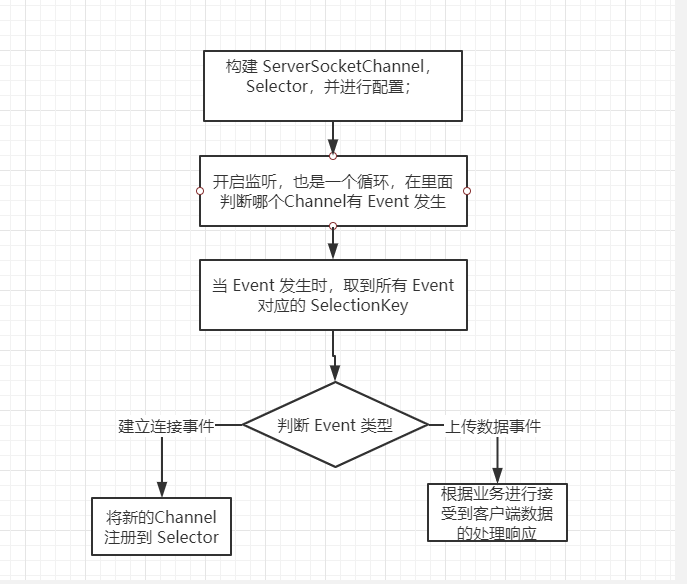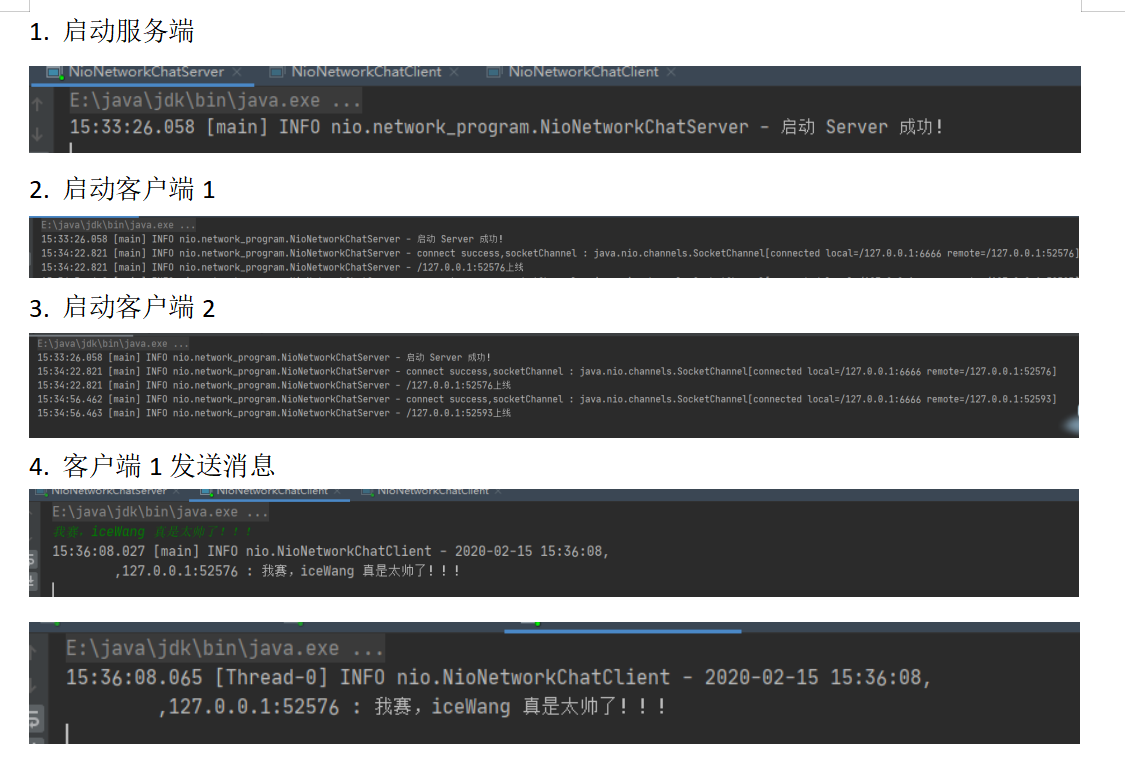在 Netty学习(3)中,我们已经学习了 Buffer 和 Channel 的概念, 接下来就让我们通过实现一个 NIO 的多人聊天服务器来深入理解 NIO 的第 3个组件:Selector。
在本文中,我们将通过实现一个网络聊天室程序,来掌握 Selector 的概念以及如何使用 NIO 来完成网络编程。

public class NioNetworkServer { private Logger logger = LoggerFactory.getLogger(NioNetworkServer.class); ServerSocketChannel serverSocketChannel; Selector selector; InetSocketAddress inetSocketAddress; public NioNetworkServer() { try { // 生成一个 ServerSocketChannel 和 Selector,并将 ServerSocketChannel 绑定到指定端口 serverSocketChannel = ServerSocketChannel.open(); selector = Selector.open(); inetSocketAddress = new InetSocketAddress(6666); serverSocketChannel.socket().bind(inetSocketAddress); serverSocketChannel.configureBlocking(false); // 将 serverSocketChannel(一开始的服务器Channel) 注册到指定selector上 // 后面给每一个连接生成的 SocketChannel,就是通过 ServerSocketChannel 来生成的 serverSocketChannel.register(selector, SelectionKey.OP_ACCEPT); } catch (IOException e) { logger.error("建立Server失败,失败原因:{0}", e); } }}?
设置一些属性,并在构造函数里设置这些属性的值
public void listen() { try { while (true) { // 没有事件发生,就干其他事 if (selector.select(3000) == 0) { continue; } // 得到有事件发生的事件集合,然后在后面可以通过其反向获取channel Set<SelectionKey> selectionKeys = selector.selectedKeys(); Iterator<SelectionKey> iterator = selectionKeys.iterator(); while (iterator.hasNext()) { SelectionKey selectionKey = iterator.next(); // 事件:有新的连接 if (selectionKey.isAcceptable()) { whenAccept(); } // 事件:读从客户端获取的数据 if (selectionKey.isReadable()) { readData(selectionKey); } iterator.remove(); } } } catch (IOException e) { logger.error("读写错误:{0}", e); } finally { } } private void whenAccept() throws IOException { // 因为此时已经有连接事件进入了,因此虽然 accept() 是阻塞的,但是在这里会直接返回 SocketChannel socketChannel = serverSocketChannel.accept(); logger.info("connect success,socketChannel : " + socketChannel.toString()); socketChannel.configureBlocking(false); socketChannel.register(selector, SelectionKey.OP_READ, ByteBuffer.allocate(1024)); //将某人上线的消息进行显示 logger.info(socketChannel.getRemoteAddress() + "上线"); } private void readData(SelectionKey selectionKey) throws IOException { SocketChannel socketChannel = (SocketChannel) selectionKey.channel(); ByteBuffer byteBuffer = ByteBuffer.allocate(1024); try { socketChannel.read(byteBuffer); String message = new String(byteBuffer.array()); logger.info("{}{}{}", LocalDateTime.now().format(DateTimeFormatter.ofPattern("yyyy-MM-dd HH:mm:ss")), "\n\t\t", message); // 向其他的客户端转发消息 sendInfoToOtherClients(socketChannel, message); } catch (Exception e) { // 在捕获到异常后,就是有客户端发送了断开连接的请求 logger.info("{},离线了。。。", socketChannel.getRemoteAddress()); sendInfoToOtherClients(socketChannel, socketChannel.getRemoteAddress() + " 离线了。。。"); // 将关闭连接的 channel 关闭 socketChannel.close(); // 将该键移除出 set selectionKey.cancel(); } }在这里,我们根据 selectionKey 来反向获取到 channel,通过 channel 将数据读入到 buffer 中,从而读进内存。
接着,将该消息转发给其他客户端。
private void sendInfoToOtherClients(SocketChannel socketChannel, String message) throws IOException { for (SelectionKey key : selector.keys()) { SelectableChannel sourceChannel = key.channel(); if (sourceChannel instanceof SocketChannel && sourceChannel != socketChannel) { SocketChannel targetChannel = (SocketChannel) sourceChannel; // 根据转发过来的字节长度,直接生成目标大小的 Buffer,然后将数据写入到客户端的 channel 中 ByteBuffer targetByteBuffer = ByteBuffer.wrap(message.getBytes()); targetChannel.write(targetByteBuffer); } } }最后,在 main 函数中启动即可。
public static void main(String[] args) { NioNetworkServer nioNetworkServer = new NioNetworkServer(); nioNetworkServer.listen(); }public class NioNetworkChatClient { private Logger logger = LoggerFactory.getLogger(NioNetworkChatClient.class); private Selector selector; private SocketChannel socketChannel; private String username; public NioNetworkChatClient() { try { selector = Selector.open(); InetSocketAddress inetSocketAddress = new InetSocketAddress("localhost", 6666); socketChannel = SocketChannel.open(inetSocketAddress); socketChannel.configureBlocking(false); socketChannel.register(selector, SelectionKey.OP_READ); username = socketChannel.getLocalAddress().toString().substring(1); } catch (Exception e) { logger.error("构建客户端错误,错误原因:{0}", e); } }}客户端的构建方法和 Server 基本一致,不同的是,Server 构建的是 ServerSocketChannel,Client 构建的是 SocketChannel,此外 Client 一开始注册的是
SelectionKey.OP_READ事件。其他基本相似。
/** * 1. 获取selector上发生的事件 * 2. 如果是读事件,则将数据通过 Channel 和 Buffer 进行操作 * 3. 处理完成后,将该key从待处理keys中删除 */ public void readInfo() { try { int readChannel = selector.select(); if (readChannel > 0) { Set<SelectionKey> selectionKeys = selector.selectedKeys(); Iterator<SelectionKey> iterator = selectionKeys.iterator(); while (iterator.hasNext()) { SelectionKey selectionKey = iterator.next(); if (selectionKey.isReadable()) { SocketChannel handingSocketChannel = (SocketChannel) selectionKey.channel(); ByteBuffer byteBuffer = ByteBuffer.allocate(1024); int read = handingSocketChannel.read(byteBuffer); if (read > 0) { String message = new String(byteBuffer.array()); logger.info("{},{},{}", LocalDateTime.now().format(DateTimeFormatter.ofPattern("yyyy-MM-dd HH:mm:ss")), "\n\t\t", message); } else { logger.info("client closed"); // 将关闭连接的 channel 关闭 handingSocketChannel.close(); // 将该键移除出 set selectionKey.cancel(); } } } iterator.remove(); } else { logger.info("当前没有 channel 可供使用!"); } } catch (IOException e) { e.printStackTrace(); } } public void sendInfo(String info) { info = username + " : " + info; try { logger.info("{},{},{}", LocalDateTime.now().format(DateTimeFormatter.ofPattern("yyyy-MM-dd HH:mm:ss")), "\n\t\t", info); socketChannel.write(ByteBuffer.wrap(info.getBytes())); } catch (IOException e) { logger.error("发送数据错误,错误原因:{0}", e); } }发送数据就很简单了,将数据简单封装一下,直接写入到 socketChannel 即可。
/** * 1. 启动一个线程来定时读取 Server 可能发送的数据,如果没有,就休眠,等待下次读取 * 2. 启动一个获取控制台输出来进行数据的发送 * * @param args */ public static void main(String[] args) { NioNetworkChatClient nioNetworkChatClient = new NioNetworkChatClient(); // 线程资源必须通过线程池提供,不允许在应用中自行显式创建线程,但跟前面一样,这里因为不是重点,就先这样用着 new Thread() { @Override public void run() { while (true) { nioNetworkChatClient.readInfo(); try { sleep(3000); } catch (Exception e) { e.printStackTrace(); } } } }.start(); Scanner scanner = new Scanner(System.in); while (scanner.hasNextLine()) { String message = scanner.nextLine(); nioNetworkChatClient.sendInfo(message); } }
后面的结果就不在多演示了,跟这里的相似,这样,我们就完成了一个聊天室的程序,所有人可以在里面进行交流。
本文我们通过一个聊天室的程序,来演示了 Selector,Channel,Buffer 结合使用的效果,通过这 3者,我们实现了一个 NIO 的网络编程程序。
但在编写这个程序的时候,相信朋友们也发现了,其异常的繁琐,中间涉及到 Buffer 的构建,Selector 的 API 使用等等。因此,在日后的使用过程中,我们就要用到 Netty 来实现现在的工作,从而减少开发的工作量了。
ps:讲了那么多,终于要到 Netty 了,不过良好的基础是学习的关键,如果不懂 Java 的 IO 模型以及 NIO 的实现方式和局限性,也不会很好的理解学习 Netty。
本文中代码已上传到 GitHub 上,地址为 https://github.com/wb1069003157/nettyPre-research ,欢迎大家来一起讨论,一起进步。

文章在公众号「iceWang」第一手更新,有兴趣的朋友可以关注公众号,第一时间看到笔者分享的各项知识点,谢谢!笔芯!